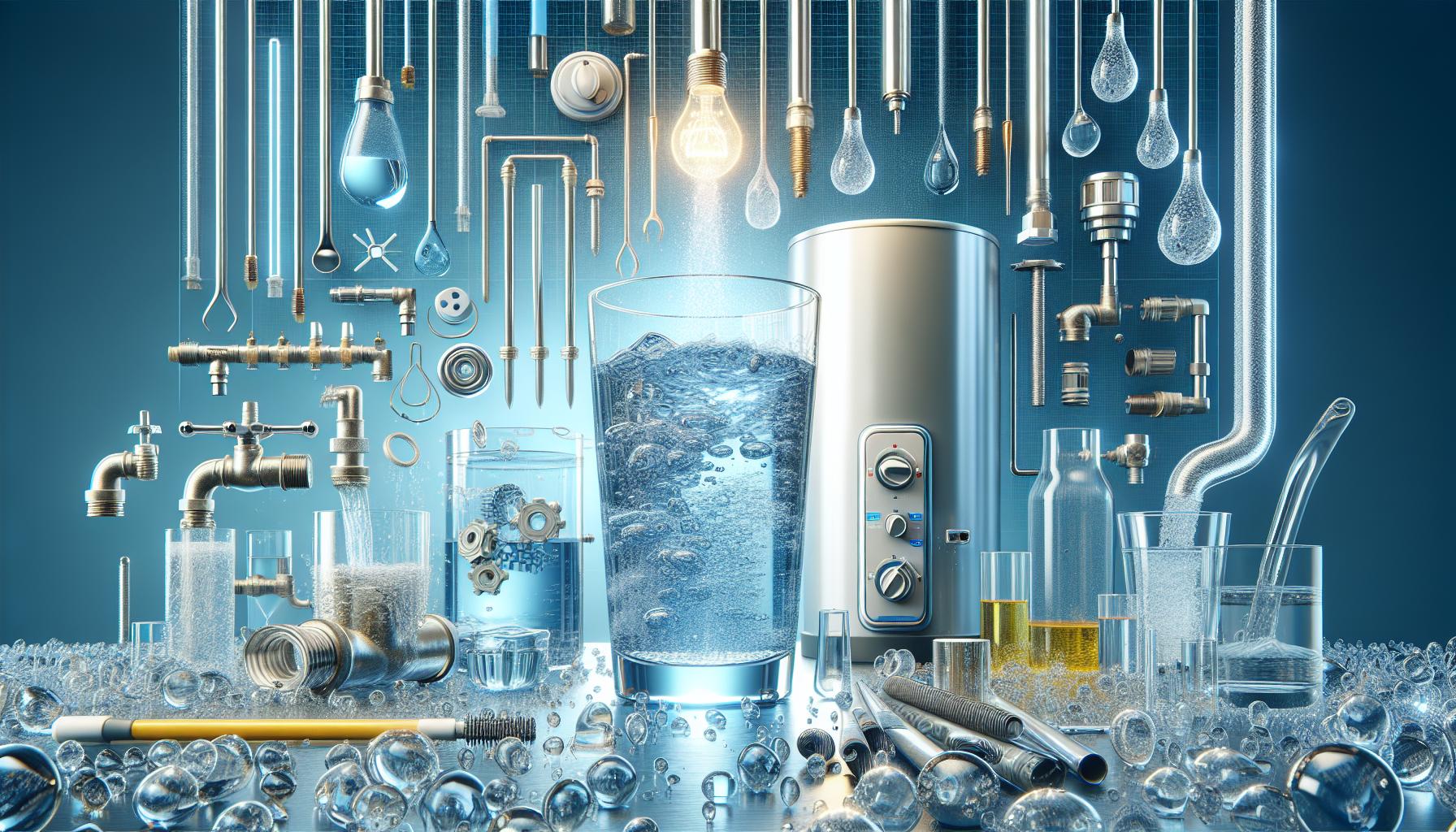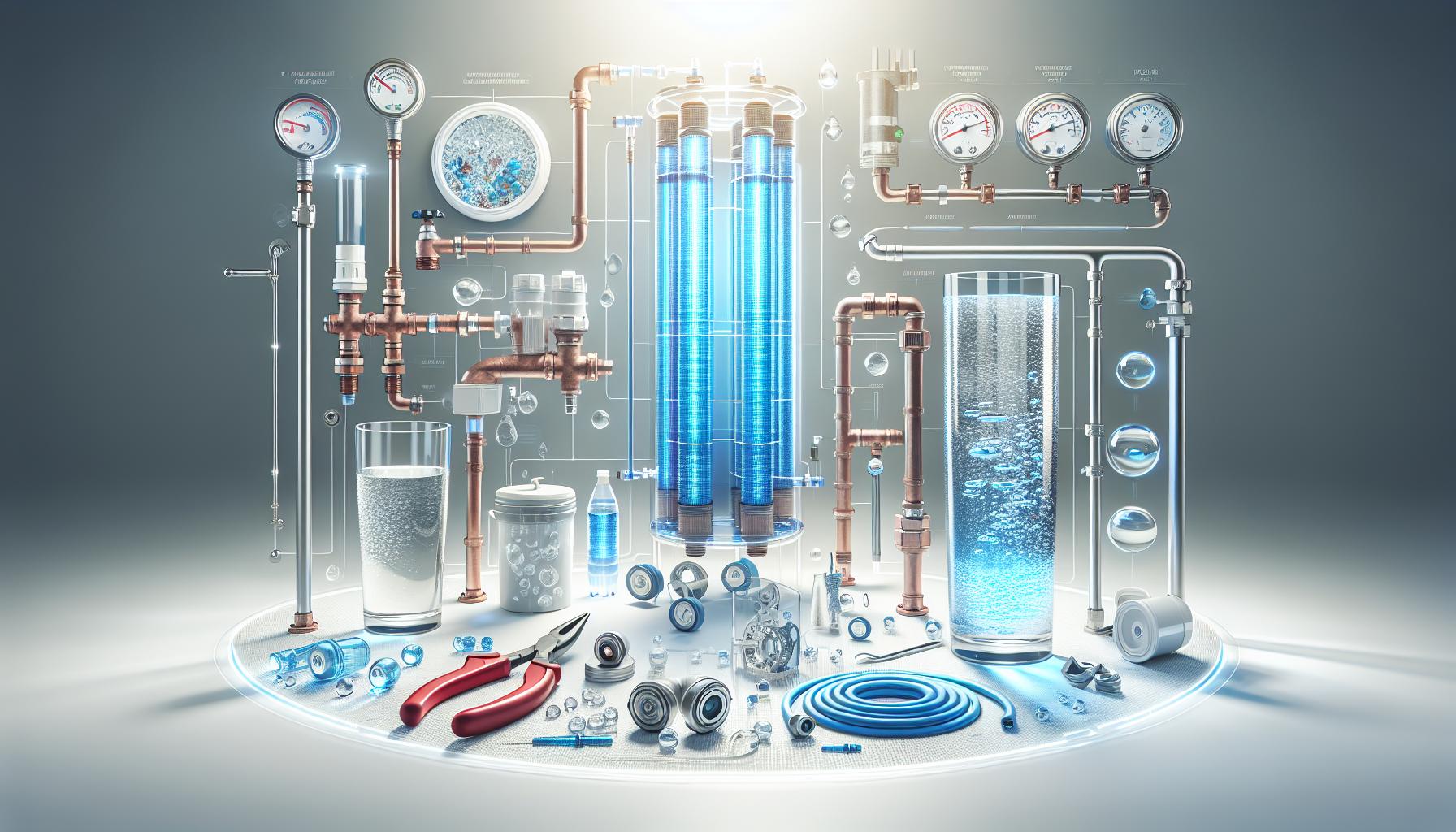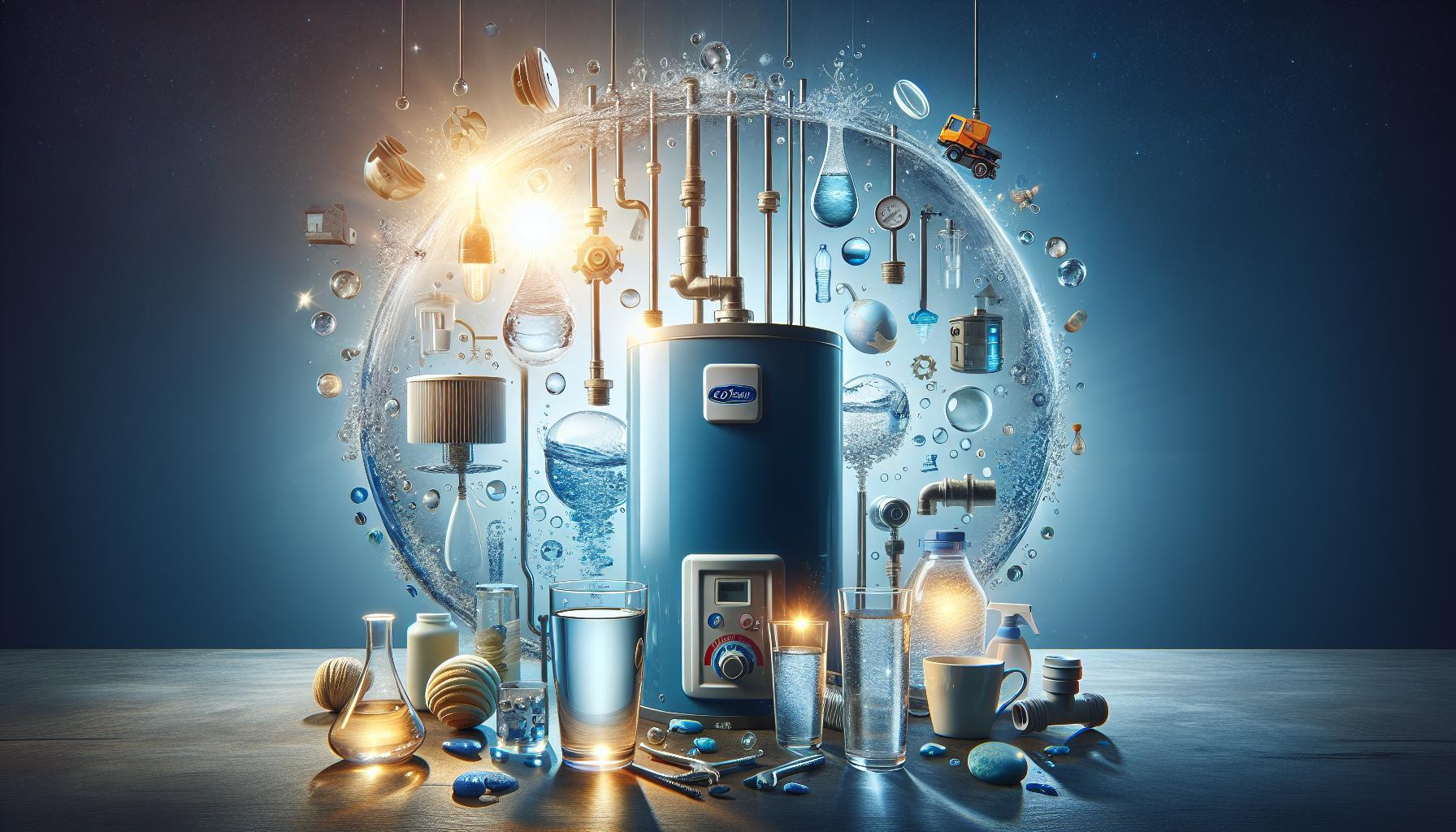Water heaters are essential for comfort, but without a vital component, they can succumb to corrosion and shorten their lifespan. Anode rods play a crucial role in protecting your tank from rust and degradation. Understanding whether your water heater has one can save you from costly repairs and ensure efficient performance for years to come.
Understanding the Anode Rod: What It Is and How It Works
Almost every traditional water heater is equipped with an essential component known as the anode rod, designed specifically to protect your tank from corrosion. This metal rod, typically made of magnesium, aluminum, or zinc, works silently in the background, extending the lifespan of your water heater by preventing rust. In environments where water is slightly acidic or contains high levels of minerals, this sacrificial anode becomes even more critical. Without it, the tank’s metal components are susceptible to deterioration, which can lead to leaks or the need for premature replacement.
The anode rod operates through a process called galvanic corrosion, which occurs when dissimilar metals are in contact with an electrolyte—in this case, water. The more reactive metal, the anode, will corrode first, protecting the less reactive tank lining from damage. Over time, the anode rod will deteriorate, which is why it’s essential to check and replace it periodically. Homeowners can help safeguard their investment in water heating by considering replacing the anode rod every three to five years, or whenever they notice a foul odor or diminished water quality.
In addition to its rust-preventing properties, understanding how the anode rod functions allows homeowners to recognize the signs of a failing rod. If you begin to notice an unpleasant smell or cloudiness in your hot water, these could be indicators of an anode rod that needs replacement. Regular maintenance checks can help catch these issues early, potentially saving you from costly repairs down the line.
To simplify the process, here’s a quick overview of the types of anode rods and their materials:
| Type | Material | Best For |
|---|---|---|
| Magnesium Anode Rod | Magnesium | Softened water |
| Aluminum Anode Rod | Aluminum | Hard water |
| Zinc Anode Rod | Zinc (often with aluminum) | Odor issues |
By being proactive and informed about the role of anode rods, you can ensure that your water heater remains efficient and reliable, ultimately extending its operational life. The question of whether all water heaters have an anode rod is indeed essential, as skipping this part can lead to significant corrosion issues and costly tank replacements. Regularly inspecting and replacing your anode rod when necessary is a straightforward yet effective way to protect your investment in home hot water systems.
Do All Water Heaters Have Anode Rods? A Quick Overview
While many homeowners may overlook the components that keep their water heaters operational, the anode rod plays a crucial role in extending the lifespan of these appliances. This often-underappreciated part is essential for protecting your tank from corrosion, which can lead to expensive repairs or replacements. But do all water heaters have an anode rod? The short answer is: yes, most do, but there are significant exceptions to be aware of.
Understanding Anode Rods in Water Heaters
Anode rods are typically made from magnesium, aluminum, or zinc and are inserted into the water heater tank. Their primary function is to act as a sacrificial metal that attracts corrosive elements present in the water, thereby preventing the tank lining from deteriorating. Over time, the anode rod corrodes instead of the tank, which allows the tank to remain intact for a longer period. Here’s a brief overview of the different types of water heaters and their relationship with anode rods:
- Traditional Tank Water Heaters: Most conventional water heaters come equipped with an anode rod, which should be inspected and replaced every few years to maintain effectiveness.
- Tankless Water Heaters: Generally, these models do not use anode rods because of their design, which does not allow for prolonged water storage and, thus, reduced corrosion risks.
- Hybrid Water Heaters: Hybrid models, which combine tank and tankless technology, often include anode rods but may also showcase different features responsible for corrosion protection.
For homeowners seeking longevity and reliable performance from their water heaters, understanding the presence and importance of anode rods is vital. If your water heater is equipped with one, regular maintenance involving inspections and timely replacements can significantly enhance its lifespan, providing a safeguard against premature wear and costly damages. As a general practice, it’s wise to consult your manufacturer’s guidelines or a plumbing professional to determine the best schedule for anode rod maintenance tailored to your specific model and household needs.
The Importance of Anode Rods in Preventing Corrosion
A water heater without an anode rod is like a ship without a rudder; it may seem operational, but it is quite literally at risk of falling apart from the inside out. Anode rods play a crucial role in extending the lifespan of your water heater by preventing corrosion, which is often the primary cause of tank failure. When corrosion occurs, it can lead to leaks, system inefficiencies, and ultimately the costly prospect of replacing the entire unit. So, what is it that makes these rods so vital when it comes to protecting your tank?
What is an Anode Rod?
An anode rod is a sacrificial component that is typically made from magnesium, aluminum, or zinc. Its primary function is to attract corrosive elements within the water heater tank. Here’s how the process works:
- Corrosion is a natural process that occurs when metal reacts with water and other elements.
- The anode rod is installed within the water tank and, over time, it corroded instead of the tank itself.
- This sacrifice helps to preserve the integrity of the tank, prolonging its lifespan significantly.
Why You Should Prioritize Anode Rod Maintenance
Neglecting the maintenance of your anode rod can lead to catastrophic results over time. Most water heaters typically come equipped with at least one anode rod, though some installations may feature multiple rods for enhanced protection. Here are some practical steps to ensure ongoing efficiency:
| Maintenance Step | Frequency | Description |
|---|---|---|
| Inspection | Every 1-2 years | Check the rod for significant corrosion; if less than ½ inch remains, replace it. |
| Replacement | Every 3-5 years | Replace the anode rod if it shows signs of excessive wear to maintain tank integrity. |
The proactive inspection and replacement of your anode rod can prevent expensive repairs or replacements down the line. Many homeowners overlook this simple maintenance task, only to discover that their tanks have started to deteriorate. By remembering that anode rods are not just optional accessories but essential components for any water heater, you can ensure that your system continues to operate efficiently for many years.
How to Inspect and Maintain Your Anode Rod
Regular inspection and maintenance of your anode rod is essential for extending the life of your water heater and preventing costly corrosion damage. While many properties with water heaters may focus solely on the operational aspects, neglecting the anode rod can lead to premature tank failure. Understanding how to effectively inspect and maintain this vital component can save homeowners both time and money in the long run.
Inspection: When and How to Check the Anode Rod
Most water heaters come equipped with an anode rod, and checking it regularly can help you gauge the condition of your tank. It’s generally recommended to inspect the rod every 1-3 years, depending on water quality and usage. Here’s how you can do it:
- Turn off the power supply: For electric heaters, switch off the breaker. For gas heaters, set the thermostat to the lowest setting.
- Shut off the water supply: Close the valve at the top of the tank to prevent any flow during your inspection.
- Drain the tank: Attach a hose to the drain valve and let some water out to reduce pressure, allowing you to safely remove the anode rod.
- Remove the anode rod: Unscrew the hex head using a socket wrench. Depending on your tank’s design, this may require some effort—be prepared for possible resistance.
Once you have the anode rod removed, examine it closely. A healthy rod is usually made from magnesium or aluminum and should still have substantial material remaining. If the rod is less than ½ inch thick or shows significant corrosion, it’s time to replace it.
Maintenance Tips for Longevity
Taking good care of your anode rod can greatly enhance the lifespan of your water heater. Here are some practical maintenance tips:
- Replace when necessary: If your inspection reveals significant wear or corrosion, replace the anode rod to keep your tank safe from rust.
- Consider water quality: If you live in an area with high mineral content or hard water, you may need to check the anode rod more frequently, as these factors can accelerate corrosion.
- Use a corrosion-resistant rod: Options like a powered anode rod can offer enhanced protection against corrosion and last longer than traditional rods.
Ultimately, routine checks and proactive maintenance of your anode rod can prevent the extensive corrosion and damage to your water heater. Owners who address the question, “Do all water heaters have an anode rod?” will find that understanding the condition of this essential component can make a significant difference in the tank’s longevity and efficiency. By ensuring that the anode rod is in good health, you’re not only safeguarding your investment but also promoting a more efficient heating system.
Signs Your Anode Rod May Need Replacement
Regular maintenance of your water heater is essential for long-term performance and efficiency. One of the key components in preventing tank corrosion is the anode rod. This simple metal rod attracts corrosive elements within the tank, extending its lifespan significantly. Yet, many homeowners remain unaware of the signs that their anode rod requires replacement. Ignoring these indicators can lead to costly repairs or even the need for a complete water heater replacement.
Visible Corrosion or Deterioration
One of the most apparent is visible corrosion or deterioration. Since the primary purpose of the anode rod is to sacrifice itself to protect the tank, it will inevitably corrode over time. If you notice that the rod is covered in white, flaky deposits or rust, it’s time to consider a replacement. Regular inspections every three to five years can help catch these issues early, as proactive maintenance is always cheaper than reactive repairs[1].
Unusual Water Odor or Discoloration
Another crucial indicator is an unusual odor or discoloration of your hot water. If your hot water starts smelling like rotten eggs or shows discoloration, it could signify that your anode rod is failing. This condition often results from bacteria thriving on the corroding anode, which can lead to unpleasant smells and poor water quality. If you experience these symptoms, inspect the anode rod or seek professional assistance to ensure your water remains safe and clean[2].
Frequent Water Heater Repairs
If you find yourself frequently repairing your water heater, it may be an indicator that the anode rod is no longer functioning effectively. Frequent leaks, tank failures, or repairs could stem from corrosion due to a degraded anode rod. By replacing the anode rod regularly, you can often extend the life of your water heater significantly, potentially doubling its lifespan[3].
In summary, keeping an eye out for these signs—corrosion or deterioration of the anode rod, unusual water odors or discoloration, and frequent repairs—will help ensure that your water heater remains in optimal condition. Proactive replacements minimize corrosion and maximize the longevity of your water heater, making it a critical maintenance step for any homeowner.
Choosing the Right Anode Rod for Your Water Heater
is essential for maximizing its lifespan and preventing costly repairs due to corrosion. Every water heater contains an anode rod designed to attract corrosive elements in the tank, which helps protect the inner lining from deterioration. Understanding the different types of anode rods and how they interact with your water supply will help you make informed decisions for long-term maintenance.
Types of Anode Rods
There are three main materials used for anode rods: magnesium, aluminum, and zinc. Each type has its unique properties and suitability depending on your water quality:
- Magnesium: This is the most common type used for residential water heaters. It is highly effective in soft water conditions and offers the best protection against corrosion.
- Aluminum: Often used in areas with hard water, aluminum rods are more affordable and versatile. However, they might create mineral deposits that can affect water quality.
- Zinc: Zinc anode rods are primarily used in water heaters that produce hydrogen sulfide gas. They minimize odor but may sacrifice some protective qualities compared to magnesium rods.
Factors to Consider
When selecting an anode rod, consider the following factors:
- Water Quality: Test your water for hardness and chemical composition. This information will help determine the best anode rod material.
- Tank Size: Ensure the anode rod fits your tank’s specifications. Larger tanks may require multiple rods to provide adequate protection.
- Replacement Frequency: Anode rods should be inspected regularly, typically every 1-3 years, depending on water quality. Choose a rod that’s easy to replace.
Practical Steps for Replacement
Replacing the anode rod is a straightforward process that can save you from major repairs. Here’s how to do it effectively:
- Turn off the water heater and disconnect the power or gas supply.
- Shut off the cold water supply to the tank and drain some water to relieve pressure.
- Remove the old anode rod using a socket wrench and inspect it for degradation. A rod that is less than 50% intact should be replaced.
- Install the new anode rod, ensuring it is tight and secure before refilling the tank.
By understanding the importance of the anode rod and how it protects your water heater, you can effectively manage and extend the lifespan of your appliance. Regularly assessing your water quality and performing maintenance can ensure that your water heater operates efficiently for years to come.
Common Myths About Anode Rods and Water Heater Longevity
Many homeowners are unaware of the crucial role anode rods play in extending the lifespan of their water heaters. This vital component serves as a safeguard against corrosion, but several misconceptions abound that can lead to confusion and potentially costly mistakes. Addressing these common myths can not only enhance your understanding but also empower you to take proactive steps in maintaining your water heater and ensuring its longevity.
Myth 1: Anode Rods Are Only Needed in Certain Types of Water Heaters
One prevalent myth is that only specific types of water heaters require anode rods. In reality, most water heaters, whether tank-style or tankless, are designed to work alongside an anode rod. This misunderstood component operates by sacrificing itself to corrode preferentially, thereby protecting the interior lining of the tank or the heat exchanger in tankless models. To illustrate:
| Water Heater Type | Anode Rod Requirement |
|---|---|
| Storage Tank Water Heater | Yes |
| Tankless Water Heater | Yes (though often integrated differently) |
| Hybrid Water Heater | Yes |
This myth’s persistence may cause neglect, leading to premature wear and potential failure in water heating systems.
Myth 2: Anode Rods Are Maintenance-Free
Another misconception is that once an anode rod is installed, it requires no further attention. In fact, these rods will degrade over time and require regular inspection and replacement to ensure optimal performance. Homeowners should check their anode rods every few years, especially in areas with hard water or high mineral content, as these factors can accelerate corrosion. Regular maintenance involves:
- Visually inspecting the condition of the anode rod.
- Testing the rod’s effectiveness by measuring its thickness.
- Actually replacing the anode rod when it has corroded significantly (usually every 3-5 years for most systems).
By keeping a check on the anode rod’s health, you can postpone costly repairs and extend the overall lifespan of your water heater.
Myth 3: All Anode Rods Are Created Equal
Not all anode rods offer the same level of protection. Homeowners often believe that any replacement rod will suffice, but variations in material and design can affect performance. The most common types include magnesium, aluminum, and zinc anode rods. Each has its own advantages and disadvantages depending on water chemistry:
- Magnesium: Preferred for their excellent corrosion resistance.
- Aluminum: More affordable but can reduce water quality due to higher levels of corrosion byproducts.
- Zinc: Often used in conjunction with aluminum to prevent electrolytic corrosion.
Choosing the right type of anode rod tailored to your water quality is essential in maximizing the protection of your water heater from corrosion and extending its life.
By debunking these myths, homeowners can become more informed about their water heating systems and the importance of anode rods in preserving them for years to come. Understanding and acting upon these realities will not only protect your tank from corrosion but also save you from unexpected repairs and replacements in the future.
Professional Tips for Extending the Life of Your Water Heater
To ensure your water heater operates efficiently for years to come, focusing on specific maintenance tasks can make a significant difference. One of the best-kept secrets of longevity is the anode rod—this small component plays a crucial role in protecting your tank from corrosion. Regular inspection and replacement of the anode rod can be the key to extending the life of your water heater.
Regular Inspection of the Anode Rod
Checking the anode rod should be a priority in your maintenance routine. This rod, typically made from magnesium, aluminum, or zinc, acts as a sacrificial barrier against rust and corrosion. Over time, it can degrade and may need to be replaced. Inspecting the anode rod every 1-3 years is advisable; if less than 50% of it remains, it’s time for a replacement. Investing a few hours periodically can save you from more costly repairs or even a complete water heater replacement later on.
Routine Flushing to Prevent Sediment Buildup
Sediment buildup in your tank can lead to inefficient heating and increased wear on your water heater. Regularly flushing the tank—ideally once a year—helps remove mineral deposits and debris that accumulate over time. To flush your water heater, turn off the power supply, attach a hose to the drain valve, and let the water flow out until it runs clear. This simple step improves efficiency and can extend the life of your appliance significantly.
Additional Maintenance Tips
In addition to monitoring the anode rod and flushing, consider the following best practices:
- Temperature Settings: Keep the temperature set to 120°F (49°C) to prevent scalding while saving energy.
- Insulation: Insulate the tank and pipes to reduce heat loss, improving energy efficiency.
- Check for Leaks: Regularly inspect connections and the tank for any signs of leaks, as even a small leak can lead to more significant damage over time.
- Professional Inspections: Schedule routine inspections with a professional plumber to catch issues early.
By implementing these maintenance tips and understanding the importance of the anode rod, homeowners can protect their tanks from corrosion and ensure a steady supply of hot water for many years. Utilize these actionable steps to not only improve your water heater’s performance but also to save money on potential repairs and replacements. Remember, maintaining your water heater is an ongoing process that pays dividends in efficiency and longevity.
Frequently asked questions
Do All Water Heaters Have an Anode Rod?
Not all water heaters come with an anode rod. However, most traditional tank water heaters do include them to protect your tank from corrosion.
The anode rod is a crucial component that sacrifices itself to prevent rusting of the tank. It’s typically made of magnesium or aluminum, designed to corrode more easily than the steel tank itself. This is essential for maintaining the longevity of your water heater and avoiding costly repairs.
If you want to learn more about how the anode rod works and its benefits, you can check out our guide on water heater maintenance.
What Is an Anode Rod and Why Is It Important?
An anode rod is a metal rod that helps to prevent corrosion in a water heater tank by attracting corrosive elements.
It acts as a sacrificial component, meaning it will corrode instead of the tank itself. This protects the internal structure of the heater, ensuring your hot water supply remains clean and efficient. Without it, your tank could start to rust, leading to leaks and the need for replacements.
Why Does My Water Heater Anode Rod Need to Be Replaced?
Your water heater’s anode rod needs to be replaced when it becomes significantly corroded, typically every 3 to 5 years.
As the anode rod sacrifices itself to protect your tank, it eventually wears down. Regular inspection can prevent larger issues, such as leaks or a rusty water supply. If you notice a foul odor or discoloration in your hot water, it might be time to check the anode rod.
Can I Install or Replace an Anode Rod Myself?
Yes, you can install or replace an anode rod yourself with the right tools and caution.
However, proper safety measures should be followed. You will need a socket wrench or a breaker bar, and it’s crucial to turn off power and water to the heater before starting. If you’re unsure, consider hiring a professional to avoid damage or injury.
How Do I Check If My Anode Rod Is Still Effective?
To check if your anode rod is still effective, you should inspect it for significant corrosion or depletion.
It’s usually recommended to conduct this check every couple of years. If you see that more than 6 inches of the metal has corroded, it’s time for a replacement. Regular checks can save you from costly repairs down the line.
What Signs Indicate My Water Heater Might Be Failing?
Signs that your water heater may be failing include strange noises, rust-colored water, and leaks around the tank.
These symptoms often indicate that there’s an issue with either the tank or the anode rod. Addressing these problems early can prevent complete failure and extend the lifespan of your unit.
Where Can I Buy a Replacement Anode Rod?
You can purchase replacement anode rods at most home improvement stores or online retailers.
When buying a new rod, ensure it’s compatible with your specific water heater model. Many stores also offer professional installation if you’re not comfortable doing it yourself.
Concluding Remarks
In conclusion, understanding the role of anode rods in water heaters is essential for maintaining the longevity and efficiency of your system. While not all water heaters come with anodes, those that do often rely on these handy components to prevent corrosion and extend the life of the tank. Regular maintenance and timely replacement of the anode rod can save you from costly repairs in the future. If you’re curious about how to check your anode rod or enhance your water heater’s performance, dive deeper into our resources or reach out for expert advice. Taking proactive steps today can ensure a reliable hot water supply for years to come!






